Which would you rather visit - a fake tomb or a real one?
- Published
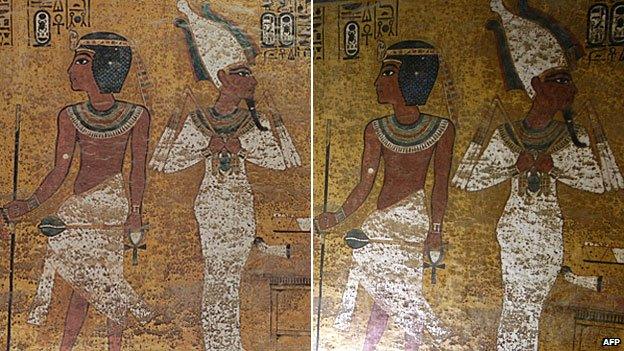
One of these photos shows the original tomb of Tutankhamun - the other shows a copy. Can you tell which is which? Answer at the bottom of the page.
A replica of King Tutankhamun's tomb is about to open in Egypt, and the authorities are hoping tourists will choose to visit this copy instead of the original. It's not the first time such steps have been taken to protect a historical site - and some reproductions are very popular.
Tutankhamun's tomb lay untouched for more than 3,000 years until the British archaeologist, Howard Carter, uncovered it in 1922. It was virtually intact - the best preserved tomb found in the Valley of the Kings.
Fast forward to 2013 and the state of the tomb is causing deep concern. Although Egypt's political unrest has reduced the flow of tourists, there have been times when more than 1,000 people a day have traipsed through it.
.jpg)
Howard Carter (kneeling) at Tutankhamun's tomb
As people enter, temperature and humidity levels change, making the walls expand and contract. As a result, the elaborately decorated plaster is coming away from the rock face.
This is where artistic and preservation specialists, Factum Arte, the Factum Foundation for Digital Technology in Conservation and the Society for the Friends of the Royal Tombs of Egypt come in.
In 2009, they spent five weeks recording every detail of the tomb, measuring 100 million points in every square metre.
They used the data to recreate the tomb, and this month they will erect their replica next to Carter's house, about 1km (0.6 miles) from the real burial site.
The copy is identical to the original "to around a tenth of a millimetre", says Adam Lowe from Factum Arte.
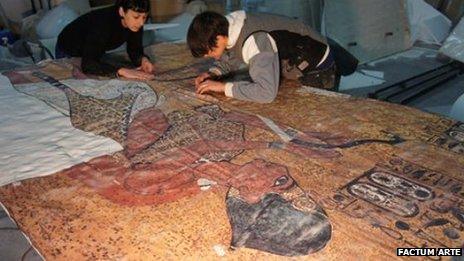
Although the real tomb may eventually need to be closed to the public to preserve it, for now visitors will have a choice - real or fake. Which one will they choose?
Lowe believes people will generally want to "become part of the force that protects it rather than a force that is leading to its destruction".
But is it more exciting to see the original? "They will have the thrill of visiting something they know is 3,000 years old and they have the guilt of knowing, as they look at it, that their presence is part of the reason why it won't be there in another 100 years' time," says Lowe.
The case of the Lascaux cave in south-west France suggests replicas can in fact prove even more popular than the original. In 1940, four boys discovered the cave, whose walls are decorated with some of the most important prehistoric art ever found.
The 17,000-year-old artworks were in perfect condition because the cave had effectively been sealed off for thousands of years.
But things changed after it was opened to the public in 1948. Mould, blackish film, green stains and calcite formed on the walls.
So in the early 1960s, when it was receiving 100,000 visitors a year, the Lascaux cave was closed. But tourists still wanted to see the images, so Lascaux II was created.
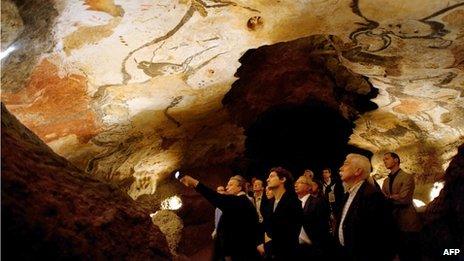
The Lascaux II replica attracts 300,000 visitors a year
This is a replica of most of the cave. It was opened in 1983 just 200m from the prehistoric site, and over the years has attracted 10 million visitors.
It is so popular that a mobile Lascaux III is now touring the world, and work on Lascaux IV - a reconstruction of the whole cave system - will start next year.
But for author and historian Tom Holland, a copy is still a copy.
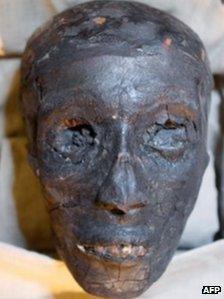
The face of Tutankhamun, on display in his tomb
"In our society there is a huge premium set on authenticity," he says. "Clearly, were there not a difference between the original and a copy, it wouldn't matter - you could make a replica and trash the original".
For him, although preservation is important, there is something unique about places like Tutankhamun's tomb and the Lascaux caves - a "quality of holiness".
"Both were constructed by people who believed in the world of the spirits, the dead and the supernatural," he says.
"You don't have to believe in a god or gods to feel a place is consecrated and has a particular quality that cannot be reproduced."
In Italy, the importance of seeing an artwork in its original home is also being emphasised - but this time by the owners of a copy.
Paolo Veronese finished his painting, The Wedding at Cana, in 1563. It was commissioned for the refectory in the Benedictine monastery of San Giorgio Maggiore in Venice, and that is where it hung for more than 200 years.
In 1797, Napoleon's invading army ripped it down, cut it up and took it to Paris. Today the painting is still in France and on display at the Louvre.
A copy of Veronese's work now hangs in the refectory in Venice, leaving tourists with an interesting question - is it better to see the original in the wrong setting or a copy in the right setting?
"The one in the Louvre is clearly more original, but seeing the facsimile at the right height, without a frame, in the place which it was designed for is a more authentic experience," says Lowe.
The copy was commissioned from Factum Arte by the Giorgio Cini Foundation, the caretaker of the Benedictine monastery.
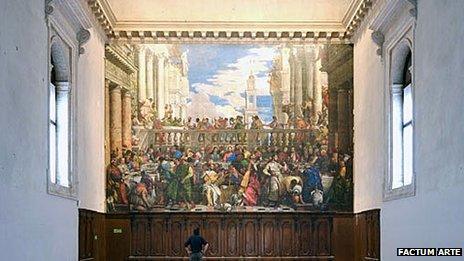
Factum Arte's copy of The Wedding at Cana, in the original setting in Venice
"I would never exchange the facsimile for the original," says the organisation's secretary general Pasquale Gagliardi. "I would be obliged to transform the refectory from a living and lived in space into a museum, with the artificial, cold, uniform light of the museums."
What's more, he says, the copy has been painted with pigments that won't alter so much over time. "In 20 years, when the original at the Louvre needs a new restoration, they will have to come here to see the original colours."
Answer: The picture on the right is the original tomb, the one on the left is the replica.
Adam Lowe spoke to Newshour on the BBC World Service.
Follow @BBCNewsMagazine, external on Twitter and on Facebook, external